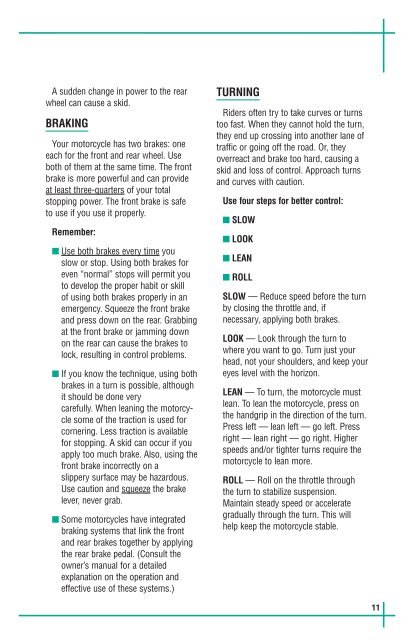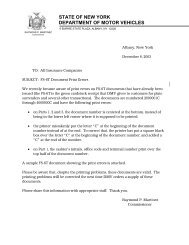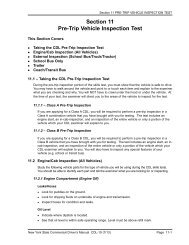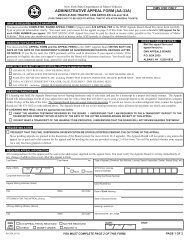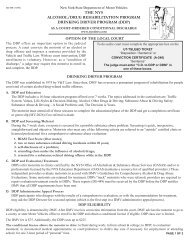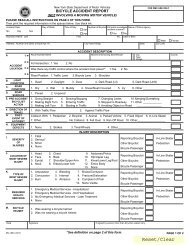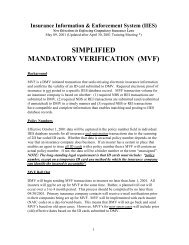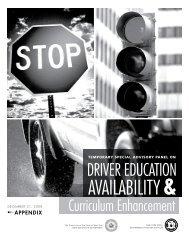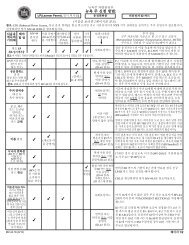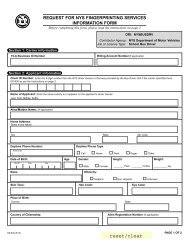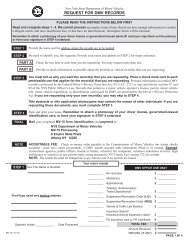Motorcycle Manual - DMV - New York State
Motorcycle Manual - DMV - New York State
Motorcycle Manual - DMV - New York State
You also want an ePaper? Increase the reach of your titles
YUMPU automatically turns print PDFs into web optimized ePapers that Google loves.
A sudden change in power to the rear<br />
wheel can cause a skid.<br />
BRAKING<br />
Your motorcycle has two brakes: one<br />
each for the front and rear wheel. Use<br />
both of them at the same time. The front<br />
brake is more powerful and can provide<br />
at least three-quarters of your total<br />
stopping power. The front brake is safe<br />
to use if you use it properly.<br />
Remember:<br />
■ Use both brakes every time you<br />
slow or stop. Using both brakes for<br />
even “normal” stops will permit you<br />
to develop the proper habit or skill<br />
of using both brakes properly in an<br />
emergency. Squeeze the front brake<br />
and press down on the rear. Grabbing<br />
at the front brake or jamming down<br />
on the rear can cause the brakes to<br />
lock, resulting in control problems.<br />
■ If you know the technique, using both<br />
brakes in a turn is possible, although<br />
it should be done very<br />
carefully. When leaning the motorcycle<br />
some of the traction is used for<br />
cornering. Less traction is available<br />
for stopping. A skid can occur if you<br />
apply too much brake. Also, using the<br />
front brake incorrectly on a<br />
slippery surface may be hazardous.<br />
Use caution and squeeze the brake<br />
lever, never grab.<br />
■ Some motorcycles have integrated<br />
braking systems that link the front<br />
and rear brakes together by applying<br />
the rear brake pedal. (Consult the<br />
owner’s manual for a detailed<br />
explanation on the operation and<br />
effective use of these systems.)<br />
TURNING<br />
Riders often try to take curves or turns<br />
too fast. When they cannot hold the turn,<br />
they end up crossing into another lane of<br />
traffic or going off the road. Or, they<br />
overreact and brake too hard, causing a<br />
skid and loss of control. Approach turns<br />
and curves with caution.<br />
Use four steps for better control:<br />
■ SLOW<br />
■ LOOK<br />
■ LEAN<br />
■ ROLL<br />
SLOW — Reduce speed before the turn<br />
by closing the throttle and, if<br />
necessary, applying both brakes.<br />
LOOK — Look through the turn to<br />
where you want to go. Turn just your<br />
head, not your shoulders, and keep your<br />
eyes level with the horizon.<br />
LEAN — To turn, the motorcycle must<br />
lean. To lean the motorcycle, press on<br />
the handgrip in the direction of the turn.<br />
Press left — lean left — go left. Press<br />
right — lean right — go right. Higher<br />
speeds and/or tighter turns require the<br />
motorcycle to lean more.<br />
ROLL — Roll on the throttle through<br />
the turn to stabilize suspension.<br />
Maintain steady speed or accelerate<br />
gradually through the turn. This will<br />
help keep the motorcycle stable.<br />
11


